 Back to Articles
Back to Articles
Stellar Lumens (XLM) Review: Goals, Features and Prospects
Stellar is an analogue of the SWIFT payment system, created on the Blockchain and on the basis of the Lumen token (XLM). The platform is supported by Stripe, IBM, Deloitte, Tempo Money Transfer, Wanxiang Group and many other large companies. In this article, learn more about how Stellar works and why it’s better than Ripple (XRP) and SWIFT.
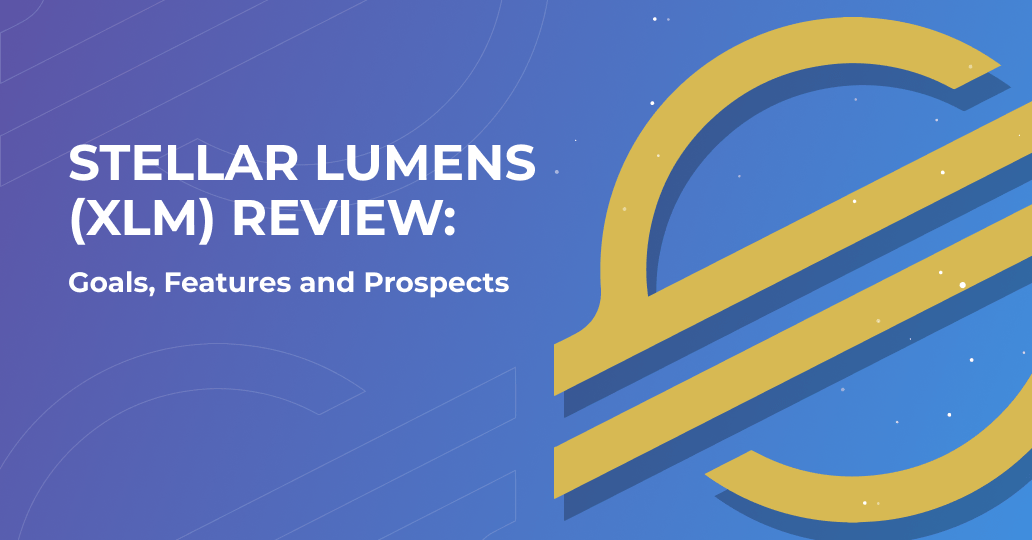
The main advantages and features of Stellar are as follows:
-
Open source software.
-
The new SCP consensus algorithm was developed by David Mazier, a computer science professor at Stanford University.
-
The payment system works with both fiat and cryptocurrency.
-
Commission is 0.0001 XLM.
-
Almost instant confirmation of transactions – 3-5 seconds.
-
High throughput – up to 1000 TPS.
What is Stellar Lumens?
The Stellar network strives to become a decentralised payment system for carrying out fast and inexpensive money transactions between banks, payment systems and people from country to country and from currency to currency. The Stellar platform is not a competitor for existing financial structures.
The Stellar ecosystem has been developed with three purposes:
-
Platform for P2P exchange. The platform has a built-in peer-to-peer decentralised crypto-exchange, StellarX (analogue of LocalBitcoins), with which anyone can exchange fiat money for cryptocurrency or other fiat.
-
Issue of cryptocurrency tokens. Stellar software makes it easy and quick to issue new tokens to create digital equivalents of all forms of money: dollars, euros, pounds, bitcoins, litecoins or gold.
-
Payment gateway for crypto and fiat. Stellar API and SDK are built to develop dApps and integrate platform capabilities into existing payment solutions. The system copes equally well with global payment solutions, exchange of any currencies and micropayments.
Project Goal
The platform was launched in 2014 by Joyce Kim and Jed McCaleb as a fork of the Ripple Protocol (XRP). According to McCaleb, the main reasons for his departure from Ripple and the launch of a new project were the ecosystem’s purposeful centralisation and the management’s interest in their revenues.
Thus, the Stellar network was originally created as a decentralised “clone” of Ripple. It is devoid of its shortcomings associated with the governance structure. A bright altruistic goal is to connect “people to budget banking services to combat poverty and human development”.
Control over the ecosystem has been given to the non-profit organisation, Stellar Development Foundation (SDF), which operates independently of the developers and is not tied to obtaining financial benefits. The organisation supports and works on the project, building relationships with developers, businesses, banks and people.
Stellar Consensus Protocol
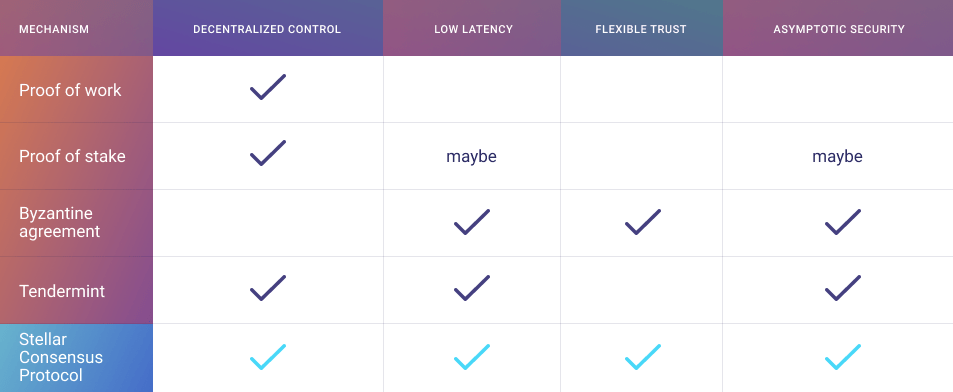
At the time of launch, Stellar used a Ripple consensus mechanism called Byzantine Fault Tolerance (BFT). It is designed in such a way as to keep the network operational even if some nodes are taken over by hackers and shut down. With Ripple, this task is solved by creating a limited closed list of validator nodes, which are completely subordinate to the main node. To confirm a transaction in such a system, 66% of validators need to be approved.
This approach went against Stellar’s goal. In 2015, the system switched to its own Stellar Consensus Protocol (SCP). This is the first implementation of the Federated Byzantine Agreement (FBA), which was developed by David Mazier.
The AMF introduces the concept of quorum slice. This is a set of nodes, the votes of which are enough to make a decision on a particular node transaction. Quorum slices are formed with the help of referral links, where each participant chooses other participants they trust, and those, in turn, choose participants whom they already trust. When a transaction needs to be confirmed, a node sends a request to its trusted nodes, which makes a decision by majority vote. If no decision is made, then the request travels further along the chain.
Let’s see how this can work with a real example. Suppose we have several banks that validate the transactions of their clients, but the clients do not fully trust these banks. Under the FBA, such clients will be able to attract a third party (a group of other banks and financial institutions) that joins the pool of validators. If the decisions of the banks and the third party coincide, the transaction is considered confirmed; if not, the request goes to a higher level and to the parties trusted by the banks and the third party.
This scheme, in contrast to the Ripple algorithm, does not depend on the Central Bank and can work with a dynamic set of nodes. The main feature here is that there should be at least one intersection between quorum slices and the chain of nodes. Stellar solves this with SDF nodes that do not claim to be the leader, but are reliable enough to be trusted.
If the system is unable to make a decision, then it stops all operations and connects specialists from the SDF. In the event of a failure or if fraud is detected, SDF compensates for the damage and punishes the “guilty” nodes.
How SCP works on a technical level is well covered in this Talks at Google video.
Role of Stellar Lumens (XLM)
The native token of the system is Lumen with an XLM ticket. However, in the media and on some exchanges, the cryptocurrency’s old name was Stellar with a STR ticket, which the platform used before switching to the Stellar Consensus Protocol (SCP).
Lumen tokens serve two purposes:
-
Preventing spam. The system charges a small commission of 0.00001 XLM for each transaction. This protects against network congestion and unnecessary transactions (spam attacks).
-
Facilitating multi-currency transactions. The token serves as a bridge between currencies, when a direct transfer between them is not possible.
Stellar vs Ripple Comparison
|
Stellar Lumens (XLM) |
Ripple (XRP) |
|
|
Target Audience |
Individuals, business, banks, fintech companies. |
Banks and financial institutions |
|
Form of Management |
Non-profit organisation |
Commercial company |
|
Decentralisation |
Yes |
No |
|
Consensus Algorithm |
Byzantine Fault Tolerance (BFT) |
Stellar Consensus Protocol (SCP) |
|
Confirmation Speed |
2-5 seconds |
4 seconds |
|
Throughput |
1000 TPS |
1500 TPS |
|
Commission |
0.00001 XLM |
0.00001 XRP |
Cryptocurrency XLM was listed on exchanges in 2017. During its first few days, it was sold at the rate of USD $0.01, and at USD $0.06 a month later. A year later, the coin peaked at USD $0.93 in January 2018. Since then, the XLM rate, along with the entire market, has dropped considerably. Now, the Lumen cryptocurrency is sold for USD $0.087 and ranks 17th in terms of capitalisation.
How to buy Stellar Lumens?
You can buy, sell and exchange XLM on the internal P2P exchanger of the project or on cryptocurrency exchanges. On the EXMO exchange, this process looks like this:
-
Go to the exchange using your account. If you do not have an account, please register and verify your account. Instructions for verification are here.
-
Enter the name of the token (XLM) in the search field and select a trading pair.
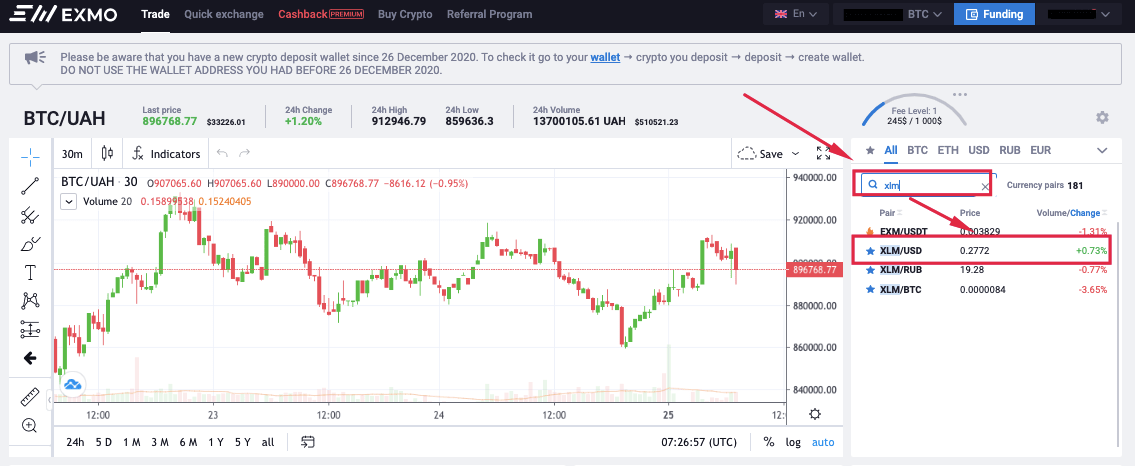
-
The chart of the selected trading pair will appear on the left, and the menu for buying and selling XLM is located below. Select the order type (“Limit”, “Market” or “Stop”), specify the amount and click “Buy”.
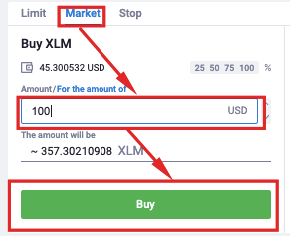
-
When choosing the “Limit” order type, you need to specify the desired selling rate. This can be done manually or by clicking on one of the orders on the right. After that, click “Buy” to place your order in the order book.
-
When the order is executed, you will have purchased XLM coins in your account, which you can save, exchange or sell.
Stellar will help Ukraine to build a national cryptocurrency
The Ministry of Digital Transformation of Ukraine signed a Memorandum of Understanding with the Stellar Development Foundation. The purpose of the Memorandum is to develop Ukrainian national cryptocurrency and partner to create a safe and transparent environment for the digital industry in Ukraine. The main objectives of the memo will be:
-
Support for projects related to crypto assets.
-
Integration of stablecoins in Ukraine.
-
Financial and legal regulation of cryptocurrencies.
-
Development of the state digital currency of the National Bank of Ukraine.
According to the Minister of Digital Transformation of Ukraine Oleksandr Bornyakov, cryptocurrency companies and startups need a reliable and secure environment for doing business. The Ministry will ensure the formation of transparent and fair rules for such an environment. The minister also added that Stellar would help Ukraine adopt other countries’ experience where the blockchain technologies have been successfully developing for a long time.
Denelle Dixon, CEO of the Stellar Development Foundation, expressed her readiness to cooperate with all interested parties and companies to develop digital currencies in Ukraine.
Mining and Staking XLM
The Stellar platform was not originally designed for mining, since the entire money supply was released immediately after the launch of the cryptocurrency. A certain type of staking was possible until 2020 – SDF distributed some XLM to everyone who had XLMs. But this practice was discontinued after some users applied the donated coins to boost network activity and manipulate the rate.
Lumens Price Prediction
Experts give a fairly positive assessment for the Lumen (XLM) in 2021 and predict that it will stay in the range USD $0.3 to $1 per token. There are two main reasons – the first is the partnership with IBM and the second is the changes that took place with the platform at the end of 2019. Stellar abandoned the inflationary model and burned 55 billion tokens. The marketing strategy and site of the project were radically redesigned. Earlier, the platform had an outdated design from the 2000s, and now it is a well-developed portal created by professional marketers.
One more reason for XLM price growth is the partnership between Stellar Development Foundation and Ukraine’s Ministry of Digital Transformation, resulting in a signed Memorandum of Understanding and Cooperation. The market reacted to this news with XLM price surge by 25% in 24 hours and by 100% in 7 days with the highest price of USD $0.364.
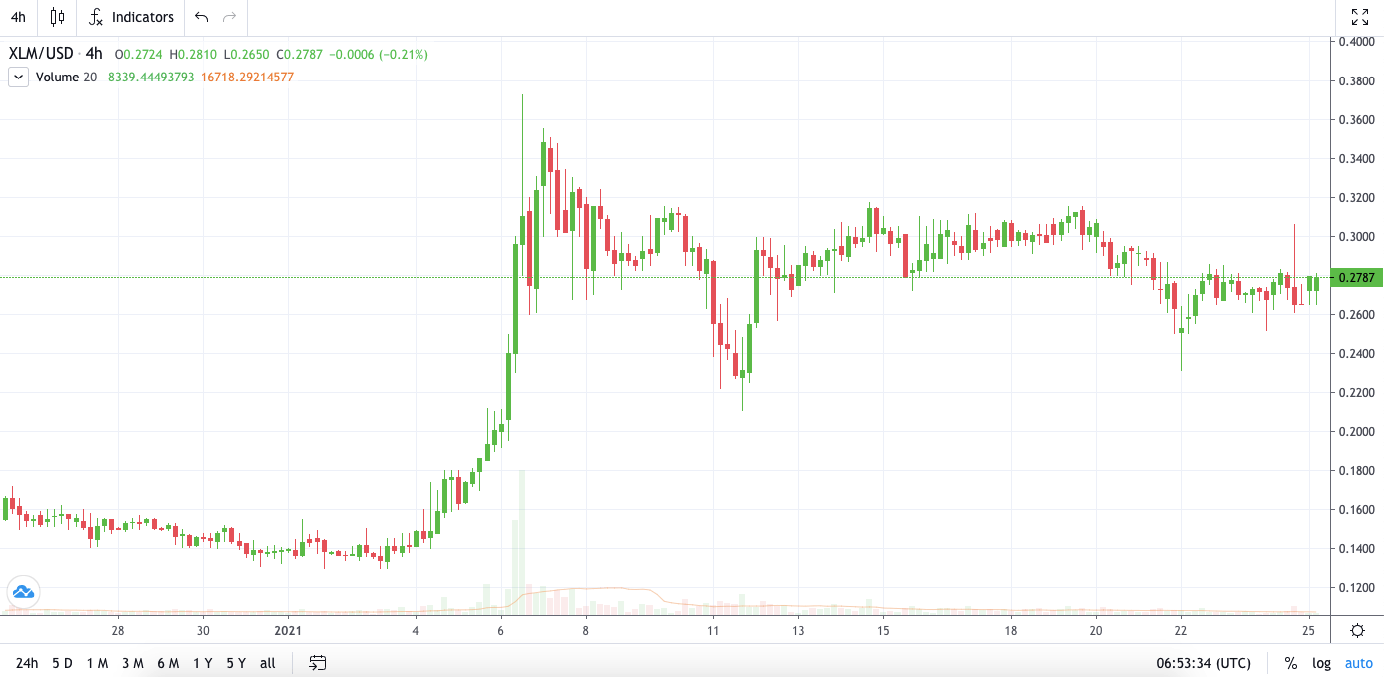
Predictions of XLM’s course by experts are as follows:
-
LongForecast expects the token price range to be in USD $0.12-0.18 in 2021, after that the rate will decline to USD $0.07 until 2023.
-
Trading Beasts predicts that the price will be in the range USD $0.27-0.40 by the end of the second quarter 2021, and by the end of the year the price may grow to USD $0.52.
-
Coinpedia makes an even more optimistic forecast: experts predict that in April 2021 the price will rise to USD $1, and over the next 5 years it may reach USD $5.
-
Coinliker predicts that the Lumen rate will rise to USD $0.6 within a year, and to USD $3.6 within the next 5 years.
As you can see, experts are quite optimistic in their forecasts for this year. However, the long-term expectations and predictions may diverge.